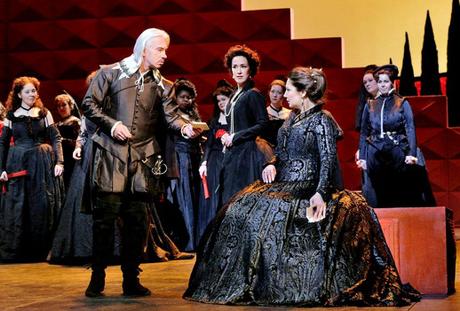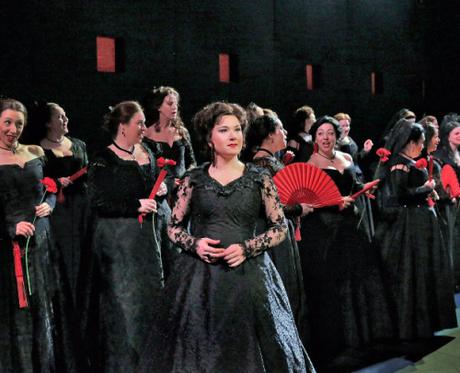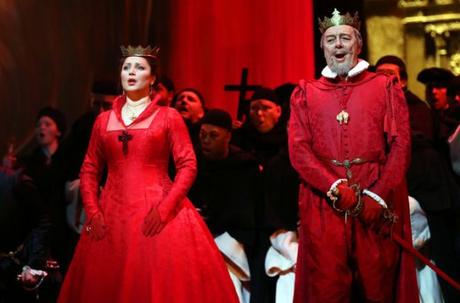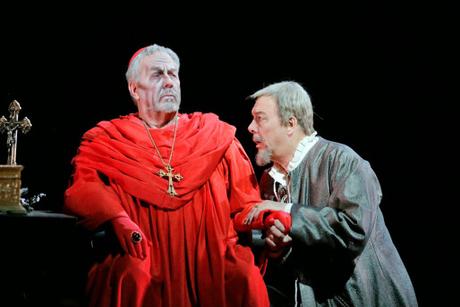“Blow, Blow, Thou Winter Wind”
 Dmitri Hvorostovsky as Rodrigo & Barbara Frittoli as Elisabetta in Verdi’s Don Carlo
Dmitri Hvorostovsky as Rodrigo & Barbara Frittoli as Elisabetta in Verdi’s Don Carlo
All season long, the Metropolitan Opera has been coping with the constant vicissitudes of New York’s miserable weather conditions. In addition to which, the loss of several major artists to illness and the never-ending flu bug, among them tenors Jonas Kaufmann and Piotr Beczala, for the company’s planned revival of Verdi’s Don Carlo and Un Ballo in Maschera left a gaping hole in the body of these respective works.
Nevertheless, while the lineup for Don Carlo was not as seriously hampered by the absence of a star lead, Ballo suffered the most sans a first-rate performer to properly bring it off (more about that at a later date). Of all Verdi’s middle period pieces, the principal role of Gustavo (and the opera itself) rises or falls with a charismatic performer. As a point of fact, the legendary Luciano Pavarotti made a specialty out of this wonderful part, his smoothly caressing manner and fabulous phrasing, as well as top-drawer characterization — one the great man found most congenial to his own buoyant personality — proved a major asset to the Met in his glory years.
Unfortunately, the highly anticipated participation of the Polish-born Mr. Beczala went for naught, as he came down with the same affliction that had earlier forced Kaufmann to bow out of Bizet’s Carmen on March 7. The virus had also flummoxed the normally unruffled Plácido Domingo (in his guise as a baritone), knocking him out of the running as he too missed the matinee performance on April 4th of Verdi’s Ernani.
As if on cue, the previously scheduled Don Carlo, Yonghoon Lee, the sensational Korean tenor who substituted for Kaufmann as Don José (which I raved about in a recent post), also fell victim to the influenza outbreak that had sidelined his illustrious predecessor. Oy vey! Not to fear! Brazilian tenor Ricardo Tamura, a native of São Paulo and an artist of Japanese and Syrian extraction, came to the rescue (well, sort of) by filling in for Mr. Lee as the volatile Don Carlo in the April 11th broadcast of the opera.
Others in the Don Carlo cast included Italian diva Barbara Frittoli as Elisabetta, Moscow-born mezzo Ekaterina Gubanova as Princess Eboli, Siberian baritone Dmitri Hvorostovsky as Rodrigo the Marquis of Posa, Italian basso Ferruccio Furlanetto as King Philip II, bass-baritone James Morris as the Grand Inquisitor, Jennifer Check as the Celestial Voice, and Eduardo Valdes as the Count of Lerma. The conductor for this performance was the brilliant young French-Canadian Yannick Nézet-Séguin.
Verdi’s darkest, gloomiest work has been a favorite at the Met ever since newly installed general manager, Rudolf Bing, inaugurated his regime in 1950 with a spectacular new production. Although the Met has continued to present Don Carlo in the more-or-less familiar Italian translation (the work originally premiered in Paris as a five-act French grand opera, with a ballet and much additional music, including an extended duet for Elisabetta and Eboli, and a completely different ensemble that concludes scene ii of Act IV), the opera has proven to be a fairly long one, lasting nearly five hours with only two intermissions.
It’s Better the Second Time Around
Unlike the previous revival led by the lugubrious Lorin Maazel, reviewed here in March 2013 (see the link: https://josmarlopes.wordpress.com/2013/03/16/parsifal-and-don-carlo-a-celebratory-feast-of-wagner-and-verdi-for-the-ravenous-opera-fan/), maestro Nézet-Séguin stressed drama and ensemble over the atmospherics. His generously flowing line kept the unwieldy opus moving and on track throughout a lengthy afternoon, while drawing breathtaking playing from the masterly Met Opera Orchestra, truly one of the world’s finest orchestral ensembles.
The massively impressive auto-da-fé sequence that ends Act III, for example, was skillfully guided and (you’ll pardon the expression) adroitly executed. Each individual component — from priests to populace, from the delegation of Flemish Deputies to the particular soloists (six in all, not including the Grand Inquisitor, who makes his entry in the next act) — had its moment to shine. And shine they did.
First of all, Barbara Frittoli had one of her best afternoons in many a season as Elisabetta, Don Carlo’s stepmother who is forced into a marriage of political expediency to Spain’s Philip II, all the while harboring amorous inclinations toward his troubled son, Carlo. This is one of the longest soprano roles Verdi ever conceived, and an overpowering one at that. To her credit, Frittoli pulled out all the emotional stops for a show-stopping “Tu che le vanità,” her last act solo before the tomb of Charles V (the same Charles V who, as Don Carlo in Verdi’s earlier Ernani, also appears before a monarch’s tomb, that of Holy Roman Emperor Charlemagne). Nézet-Séguin provided fine accompaniment throughout, the brass and violin sections offering a perfect counterpoint to her mournful pleas for aid.

As her supposed rival Eboli, Russian mezzo Ekaterina Gubanova had thrilling if less than focused high notes, along with acceptable coloratura passagework in her Act II “Song of the Veil,” ably seconded by the chirpy soprano of Amanda Woodbury as the page Tebaldo. Later on, her forceful rendition of “O don fatale,” a real crowd pleaser, brought the curtain down on her flamboyantly acted principessa. Previously, Gubanova has acquitted herself well in such varied assignments as Jane Seymour in Donizetti’s Anna Bolena and as the courtesan Giulietta who brings the title hero to his downfall in Offenbach’s The Tales of Hoffmann.
And now, we get to the male contingent. This is where things get difficult for me. In the first place, to have a fellow Brazilian make his broadcast debut in such a demanding role in last-minute fashion, and with such first-rate company as Hvorostovsky, Furlanetto and Morris, not to mention the other cast members, must be a dream come true for any up-and-coming young artist. Then again, it could also be a nightmare on Elm Street, or Broadway and 64th Street as this case proved.
So which was it for tenor Tamura? A little bit of both, I’m afraid. While possessing a pleasing enough tenor with clean Italian diction and good projection, Tamura started to land his basically lyric instrument in trouble almost from the start. To judge him on his totally unexpected appearance would be unfair at best, so I will refrain from comments deemed too harsh or condescending.
That said, I must take the Met to task for its inadequate cover policy, especially at the shy-high prices the company charges for their seats. A similar situation developed a few seasons back when tenor Ramón Vargas took sick and was covered by substitute Salvatore Cordella as Nemorino in The Elixir of Love. The performance was saved, of course, but the end result was far from desirable.

Broadcast nerves may have prevented Tamura from performing at his best. It may also have thrown him for a quick loop. He sang himself hoarse in Act III (with noticeable high-note difficulty in the powerhouse trio with Rodrigo and Eboli, a sign that all was not going well). By the time the curtain came down on the auto-da-fé, one got the impression that Tamura might have set himself ablaze: from the sound of it, his vocal chords were totally shot and on fire. I felt certain that a statement was imminent, informing the public of Tamura’s sudden indisposition. But who would the Met put in his place? Why, Tamura, of course. Actually, it was announced that he would gamely soldier on despite his apparent handicap.
Miraculously, Ricardo seemed to have “recovered” somewhat in Act IV, his voice holding out long enough to finish the Prison Scene in slightly better condition than when he started. However, losing strength as he went, by Act V Tamura experienced an abrupt turn for the worse. He was once again left without a voice. The now completely inaudible tenor plowed on to the inevitable finish, whereby he was dragged away by the mysterious Friar, who has revealed himself to be the long-lost Emperor Charles V, in one of Verdi’s least convincing (and most confusing) endings. By now, Tamura may have wished to join the emperor in the tomb, but the Met audience greeted him with warm applause for bravely continuing on with the show. A nice show of support!
On the opposite side of the ledger, things picked up with the entrance of the suavely elegant Dmitri Hvorostovsky as Rodrigo. Sounding every inch the aristocrat, Dmitri thrilled audiences with his vibrant tone. A veritable molten lava of sound and Italianate cantilena line, he outdid himself in delivering one of the most mellifluous and full-throated readings of this part that this consummate and impeccably talented artist was capable of providing. All the boldness, courage and nobility implicit in this character were brought to bear on the developing drama. Hvorostovsy’s quite considerable best served the part well. Indeed, we were treated to a first-class presentation every step of the way.
During one of the intermission features, Hvorostovsky claimed in an interview that his upcoming death scene always left him vocally and emotionally drained. He wasn’t kidding! In many ways, Rodrigo’s elaborately sung “Per me giunto,” which proceeded his death, was the highpoint of the story, made more so by Dmitri’s careful attention to words and the way he maintained control over of that long Verdian line. Consequently, his supremely nuanced “Oh Carlo, ascolta,” may have been anticlimactic but nonetheless spotlighted his bravura singing at its most robust.
Hand in hand with this performance was an even more convincing one from the veteran Ferruccio Furlanetto. His trademark Phillip II has long been this singer’s most engaging stage part. Here, we were treated to an even more subtle rendition of the character’s great third act soliloquy, “Ella giammai m’amo,” the monarch’s inner musings and grave misgivings regarding his loveless marriage to the much younger Elisabetta, as well as his suspicions concerning his hypersensitive son, were all beautifully expressed in an episode of near Shakespearean majesty and sorrow. Furlanetto, too, earned a massive ovation for his formidable acting skills and pleasurable vocal display. Well done, Signore!

It was unfortunate that the subsequent episode with the Grand Inquisitor, another of Verdi’s most ingenious and marvelously expository sequences involving two lower-voiced artists, went almost by the wayside, no thanks to James Morris’ mostly subdued output. At this late stage in his distinguished Met career, Mr. Morris, formerly one of the world’s finest interpreters of Wotan in Wagner’s Ring cycle, was too dry of tone and lacked the requisite intensity implicit in the Inquisitor’s words and plunging vocal line. I am convinced, however, that his formidable six-foot four-inch frame filled the role’s physical requirements better than his wan vocalism.
Speaking of which, Robert Pomakov’s blandly portrayed Friar was no better to these ears than his previous assumption of Count Monterone in Rigoletto. What’s needed at that point in the drama is a dominant Voice of Doom, a sort of avenging Commendatore figure (in disguise that is to say). The same goes for the Friar, who must sound chilling enough to freeze the marrow of one’s bones, yet embody royalty. What we got instead were subpar sonorities that neither excited the public nor delivered on the promise of a thoroughly satisfying radio broadcast.
Oh, well, so be it. The Metropolitan has much to learn, and much more to improve upon, in the sensitive area of cover artists. The only question I have is this: Is there a doctor anywhere in the opera house who can help diagnose the problem of a lack of good cover singers and, in the end, come up with an acceptable solution to poor coverage? One can only hope.
(To be continued…)
Copyright © 2015 by Josmar F. Lopes

